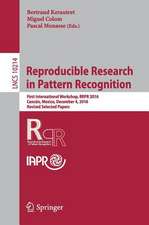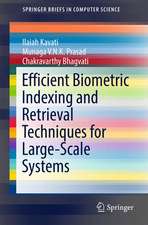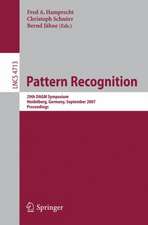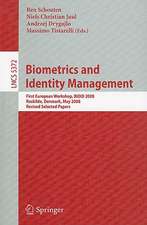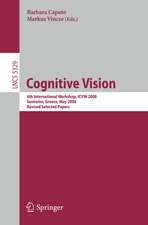Advances in Applied Self-Organizing Systems: Advanced Information and Knowledge Processing
Editat de Mikhail Prokopenkoen Limba Engleză Paperback – 6 iun 2015
The last several decades have seen much progress from original ideas of “emergent functionality” and “design for emergence”, to sophisticated mathematical formalisms of “guided self-organization”. And yet the main challenge remains, attracting the best scientific and engineering expertise to this elusive problem.
This book presents state-of-the-practice of successfully engineered self-organizing systems, and examines ways to balance design and self-organization in the context of applications.
As demonstrated in this second edition of Advances in Applied Self-Organizing Systems, finding this balance helps to deal with practical challenges as diverse as navigation of microscopic robots within blood vessels, self-monitoring aerospace vehicles, collective and modular robotics adapted for autonomous reconnaissance and surveillance, self-managing grids and multiprocessor scheduling, data visualization and self-modifying digital and analog circuitry, intrusion detection in computer networks, reconstruction of hydro-physical fields, traffic management, immunocomputing and nature-inspired computation.
Many algorithms proposed and discussed in this volume are biologically inspired, and the reader will also gain an insight into cellular automata, genetic algorithms, artificial immune systems, snake-like locomotion, ant foraging, birds flocking, neuromorphic circuits, amongst others. Demonstrating the practical relevance and applicability of self-organization, Advances in Applied Self-OrganizingSystems will be an invaluable tool for advanced students and researchers in a wide range of fields.
| Toate formatele și edițiile | Preț | Express |
|---|---|---|
| Paperback (1) | 652.41 lei 6-8 săpt. | |
| SPRINGER LONDON – 6 iun 2015 | 652.41 lei 6-8 săpt. | |
| Hardback (1) | 658.84 lei 6-8 săpt. | |
| SPRINGER LONDON – 24 mai 2013 | 658.84 lei 6-8 săpt. |
Din seria Advanced Information and Knowledge Processing
- 20%
 Preț: 330.44 lei
Preț: 330.44 lei - 20%
 Preț: 53.43 lei
Preț: 53.43 lei - 20%
 Preț: 1042.28 lei
Preț: 1042.28 lei - 18%
 Preț: 726.85 lei
Preț: 726.85 lei - 20%
 Preț: 646.30 lei
Preț: 646.30 lei - 20%
 Preț: 990.80 lei
Preț: 990.80 lei - 20%
 Preț: 647.61 lei
Preț: 647.61 lei - 20%
 Preț: 996.56 lei
Preț: 996.56 lei - 20%
 Preț: 994.40 lei
Preț: 994.40 lei - 20%
 Preț: 985.03 lei
Preț: 985.03 lei - 20%
 Preț: 654.37 lei
Preț: 654.37 lei - 20%
 Preț: 989.79 lei
Preț: 989.79 lei - 20%
 Preț: 991.27 lei
Preț: 991.27 lei - 15%
 Preț: 645.79 lei
Preț: 645.79 lei - 20%
 Preț: 817.55 lei
Preț: 817.55 lei - 20%
 Preț: 991.46 lei
Preț: 991.46 lei - 18%
 Preț: 1114.83 lei
Preț: 1114.83 lei - 20%
 Preț: 589.93 lei
Preț: 589.93 lei - 20%
 Preț: 995.75 lei
Preț: 995.75 lei -
 Preț: 454.92 lei
Preț: 454.92 lei - 20%
 Preț: 992.62 lei
Preț: 992.62 lei - 20%
 Preț: 645.14 lei
Preț: 645.14 lei - 20%
 Preț: 647.61 lei
Preț: 647.61 lei - 20%
 Preț: 638.69 lei
Preț: 638.69 lei - 18%
 Preț: 955.08 lei
Preț: 955.08 lei - 20%
 Preț: 643.97 lei
Preț: 643.97 lei - 20%
 Preț: 983.02 lei
Preț: 983.02 lei - 20%
 Preț: 645.31 lei
Preț: 645.31 lei - 18%
 Preț: 950.96 lei
Preț: 950.96 lei - 20%
 Preț: 921.17 lei
Preț: 921.17 lei - 20%
 Preț: 653.71 lei
Preț: 653.71 lei - 20%
 Preț: 988.00 lei
Preț: 988.00 lei - 18%
 Preț: 947.67 lei
Preț: 947.67 lei - 20%
 Preț: 1004.99 lei
Preț: 1004.99 lei - 20%
 Preț: 650.92 lei
Preț: 650.92 lei - 20%
 Preț: 998.21 lei
Preț: 998.21 lei - 20%
 Preț: 642.65 lei
Preț: 642.65 lei - 20%
 Preț: 988.00 lei
Preț: 988.00 lei - 20%
 Preț: 997.38 lei
Preț: 997.38 lei - 20%
 Preț: 650.59 lei
Preț: 650.59 lei - 20%
 Preț: 647.61 lei
Preț: 647.61 lei
Preț: 652.41 lei
Preț vechi: 815.50 lei
-20% Nou
Puncte Express: 979
Preț estimativ în valută:
124.86€ • 129.87$ • 103.07£
124.86€ • 129.87$ • 103.07£
Carte tipărită la comandă
Livrare economică 14-28 aprilie
Preluare comenzi: 021 569.72.76
Specificații
ISBN-13: 9781447158998
ISBN-10: 1447158997
Pagini: 436
Ilustrații: X, 426 p.
Dimensiuni: 155 x 235 x 23 mm
Greutate: 0.61 kg
Ediția:2nd ed. 2013
Editura: SPRINGER LONDON
Colecția Springer
Seria Advanced Information and Knowledge Processing
Locul publicării:London, United Kingdom
ISBN-10: 1447158997
Pagini: 436
Ilustrații: X, 426 p.
Dimensiuni: 155 x 235 x 23 mm
Greutate: 0.61 kg
Ediția:2nd ed. 2013
Editura: SPRINGER LONDON
Colecția Springer
Seria Advanced Information and Knowledge Processing
Locul publicării:London, United Kingdom
Public țintă
ResearchCuprins
Preface.- Part I – Introduction.- Design versus Self-Organization.- Foundations and Formalizations of Self-Organization.- Part II – Distributed Management and Control.- Self-Organizing Traffic Lights: A Realistic Simulation.- Self-Organizing Sensing of Structures: Monitoring a Space Vehicle Thermal Protection System.- Decentralized Decision Making for Ad-hoc Multi-Agent Systems.- Learning Mutation Strategies for Evaluation and Adaptation of a Simulated Snakebot.- Self-Organization as Phase Transition in Decentralized Groups of Robots: A Study Based on Boltzmann Entropy.- Distributed Control of Microscopic Robots in Biomedical Applications.- Part III – Self-Organizing Computation.- Self-Organizing Computing Systems: Songline Processors.- Self-Organizing Nomadic Services in Grids.- Immune System Support for Scheduling.- Formal Immune Networks: Self-Organization and Real-World Applications.- A Model for Self-Organizing Data Visualization using Decentralized Multi-Agent Systems.- Memristive Excitable Automata: Structural Dynamics, Phenomenology, Localizations and Conductive Pathways.- Part IV – Discussion.- A Turing Test for Emergence.- Index.
Textul de pe ultima copertă
How do we design a self-organizing system? Is it possible to validate and control non-deterministic dynamics? What is the right balance between the emergent patterns that bring robustness, adaptability and scalability, and the traditional need for verification and validation of the outcomes?
The last several decades have seen much progress from original ideas of “emergent functionality” and “design for emergence”, to sophisticated mathematical formalisms of “guided self-organization”. And yet the main challenge remains, attracting the best scientific and engineering expertise to this elusive problem.
This book presents state-of-the-practice of successfully engineered self-organizing systems, and examines ways to balance design and self-organization in the context of applications.
As demonstrated in this second edition of Advances in Applied Self-Organizing Systems, finding this balance helps to deal with practical challenges as diverse as navigation of microscopic robots within blood vessels, self-monitoring aerospace vehicles, collective and modular robotics adapted for autonomous reconnaissance and surveillance, self-managing grids and multiprocessor scheduling, data visualization and self-modifying digital and analog circuitry, intrusion detection in computer networks, reconstruction of hydro-physical fields, traffic management, immunocomputing and nature-inspired computation.
Many algorithms proposed and discussed in this volume are biologically inspired, and the reader will also gain an insight into cellular automata, genetic algorithms, artificial immune systems, snake-like locomotion, ant foraging, birds flocking, neuromorphic circuits, amongst others. Demonstrating the practical relevance and applicability of self-organization, Advances in Applied Self-OrganizingSystems will be an invaluable tool for advanced students and researchers in a wide range of fields.
The last several decades have seen much progress from original ideas of “emergent functionality” and “design for emergence”, to sophisticated mathematical formalisms of “guided self-organization”. And yet the main challenge remains, attracting the best scientific and engineering expertise to this elusive problem.
This book presents state-of-the-practice of successfully engineered self-organizing systems, and examines ways to balance design and self-organization in the context of applications.
As demonstrated in this second edition of Advances in Applied Self-Organizing Systems, finding this balance helps to deal with practical challenges as diverse as navigation of microscopic robots within blood vessels, self-monitoring aerospace vehicles, collective and modular robotics adapted for autonomous reconnaissance and surveillance, self-managing grids and multiprocessor scheduling, data visualization and self-modifying digital and analog circuitry, intrusion detection in computer networks, reconstruction of hydro-physical fields, traffic management, immunocomputing and nature-inspired computation.
Many algorithms proposed and discussed in this volume are biologically inspired, and the reader will also gain an insight into cellular automata, genetic algorithms, artificial immune systems, snake-like locomotion, ant foraging, birds flocking, neuromorphic circuits, amongst others. Demonstrating the practical relevance and applicability of self-organization, Advances in Applied Self-OrganizingSystems will be an invaluable tool for advanced students and researchers in a wide range of fields.
Caracteristici
Revised second edition includes concise summaries of the research carried out in the last five years on self-organizing systems as well as extending some topics Considers several novel applications, extending the range of applicability of self-organizing systems Practical case studies examine successful applications of self-organization, identify essential causes for their successes, and propose guiding principles for future developments Includes supplementary material: sn.pub/extras













